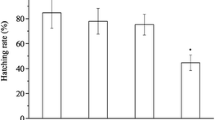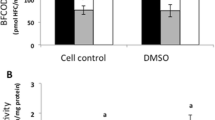Abstract
Endocrine-disrupting compounds (EDC) are predominantly investigated with respect to their ability to mimic or block estrogenic actions. However, it is well-known that EDC can act as agonists or antagonists of androgen- and estrogen-response systems. For that reason, there is an obvious need for bioassays providing the possibility of detecting (anti-)estrogenic and (anti-)androgenic effects. The retinol-binding protein (RBP) seems to be a useful molecular biomarker for assessing all modes of action of EDC, because it is regulated by sex steroid hormones. This study was conducted to establish RBP as a biomarker for determination of (anti-)estrogenic and (anti-)androgenic effects of EDC using a Xenopus laevis primary hepatocyte culture system. It could be shown that RBP mRNA expression in X. laevis hepatocytes was stimulated by estrogens in a dose-dependant manner whereas a combination of estrogen and androgen or estrogen and anti-estrogen treatment suppressed estrogenic stimulating effects. Androgens testosterone and dihydrotestosterone were able to reduce RBP mRNA expression and the anti-androgen vinclozolin could abolish the mRNA synthesis-suppressing activity of the androgen dihydrotestosterone. These results clearly demonstrated that RBP mRNA expression patterns in Xenopus laevis hepatocytes have different modes of (anti-)estrogenic and (anti-)androgenic action and can be used for examination of suspected EDC. Moreover, water samples from sewage-treatment plant effluents were applied to liver cells and expression levels of RBP and estrogen receptor mRNA (a known estrogenic biomarker) were detected. These samples had high estrogenicity but caused low to moderate induction of RBP mRNA synthesis, leading to the conclusion that RBP levels represent the sum of all possible effects (estrogenic and other effects) of EDC in environmental samples.







Similar content being viewed by others
Abbreviations
- EDC:
-
Endocrine-disrupting compounds
- RBP:
-
Retinol-binding protein
- STP:
-
Sewage-treatment plants
- ER:
-
Estrogen receptor
- AR:
-
Androgen receptor
- E2:
-
17β-Estradiol
- EE:
-
Ethynylestradiol
- T:
-
Testosterone
- DHT:
-
Dihydrotestosterone
- MT:
-
Methyltestosterone
- TAM:
-
Tamoxifen
- VC:
-
Vinclozolin
- CMF:
-
Calcium-magnesium free
- ME:
-
Minimal essential
References
Tyler CR, Jobling S, Sumpter JP (1998) Crit Rev Toxicol 28:319–361
McLachlan JA (2001) Endocr Rev 22:319–341
Kloas W (2002) Int Rev Cytol 216:1–57
Opitz R, Levy G, Bögi C, Lutz I, Kloas W (2002) Recent Res Devel Endocrinol 3:127–170
Sheehan DM (2000) Proc Exp Biol Med 224:57–60
Levy G, Lutz I, Krüger A, Kloas W (2003) Environ Res 94:102–111
Zacharewski T (1998) Environ Health Perspect 106:577–582
Burnison BK, Comba ME, Carey JH, Parrott J, Sherry JP (1999) Environ Toxicol Chem 18:2882–2887
Kloas W, Lutz I, Einspanier R (1999) Sci Total Environ 225:59–68
Lutz I, Kloas W (1999) Sci Total Environ 225:49–57
Bögi C, Levy G, Lutz I, Kloas W (2002) Comp Biochem Physiol B Biochem Mol Biol 133:559–570
McKearin DM, Barton MC, Keller MJ, Shapiro DJ (1987) J Biol Chem 262:4939–4942
McKearin DM, Shapiro DJ (1988) J Biol Chem 263:3261–3265
Weiler I, Lew D, Shapiro D (1987) Mol Endocrinol 1:355–362
Dosch R, Gawantka V, Delius H, Blumenstock H, Niehrs C (1997) Development 124:2325–2334
Dostal D, Rothblum K, Baker K (1994) Anal Biochem 223:239–250
Snyder ST, Keith TL, Verbrugge DA, Snyder EM, Gross TS, Kannan K, Giesy JP (1999) Environ Sci Technol 33:2814–2820
Carey C, Heyer WR, Wilkinson J, Alford RA, Arntzen JW, Halliday T, Hungerford L, Lips KR, Middleton EM, Orchard SA, Rand AS (2001) Conserv Biol 15:903–913
Funkenstein B (2001) Comp Biochem Physiol B 129:613–622
Wijayaratne AL, Nagel SC, Paige LA, Christensen DJ, Norris JD, Fowlkes DM, McDonnell DP (1999) Endocrinology 140:5828–5840
Baartrup E, Junge M (2001) Environ Health Perspect 109:1063–1070
Kelce WR, Monosson E, Gamcsik MP, Laws SC, Gray LE (1994) Toxicol Appl Pharmacol 126:275–285
Kirk LA, Tyler CR, Lye CM, Sumpter JP (2002) Environ Toxicol Chem 21:972–979
Körner W, Bolz U, Triebskorn R, Schwaiger J, Negele R-D, Marx A, Hagenmaier H (2001) J Aquat Ecosystem Stress Recov 8:215–229
Thomas KV, Hurst MR, Matthiessen P, McHugh M, Smith A, Waldock MJ (2002) Environ Toxicol Chem 21:1456–1461
Harries JE, Jobling S, Sumpter JP, Sheahan DA, Matthiessen P, Neall P, Tylor T, Zaman N (1997) Environ Toxicol Chem 16, 534–542
Acknowledgements
This work was supported by the Ministry of Environment and Traffic Baden-Württemberg, Stuttgart, Germany via the research program BW-Plus, grant BWB 20006. The authors would like to thank A. Tillack, A. Lüder, and W. Schumacher for excellent technical assistance.
Author information
Authors and Affiliations
Corresponding author
Rights and permissions
About this article
Cite this article
Levy, G., Lutz, I., Krüger, A. et al. Retinol-binding protein as a biomarker to assess endocrine-disrupting compounds in the environment. Anal Bioanal Chem 378, 676–683 (2004). https://doi.org/10.1007/s00216-003-2341-z
Received:
Accepted:
Published:
Issue Date:
DOI: https://doi.org/10.1007/s00216-003-2341-z




